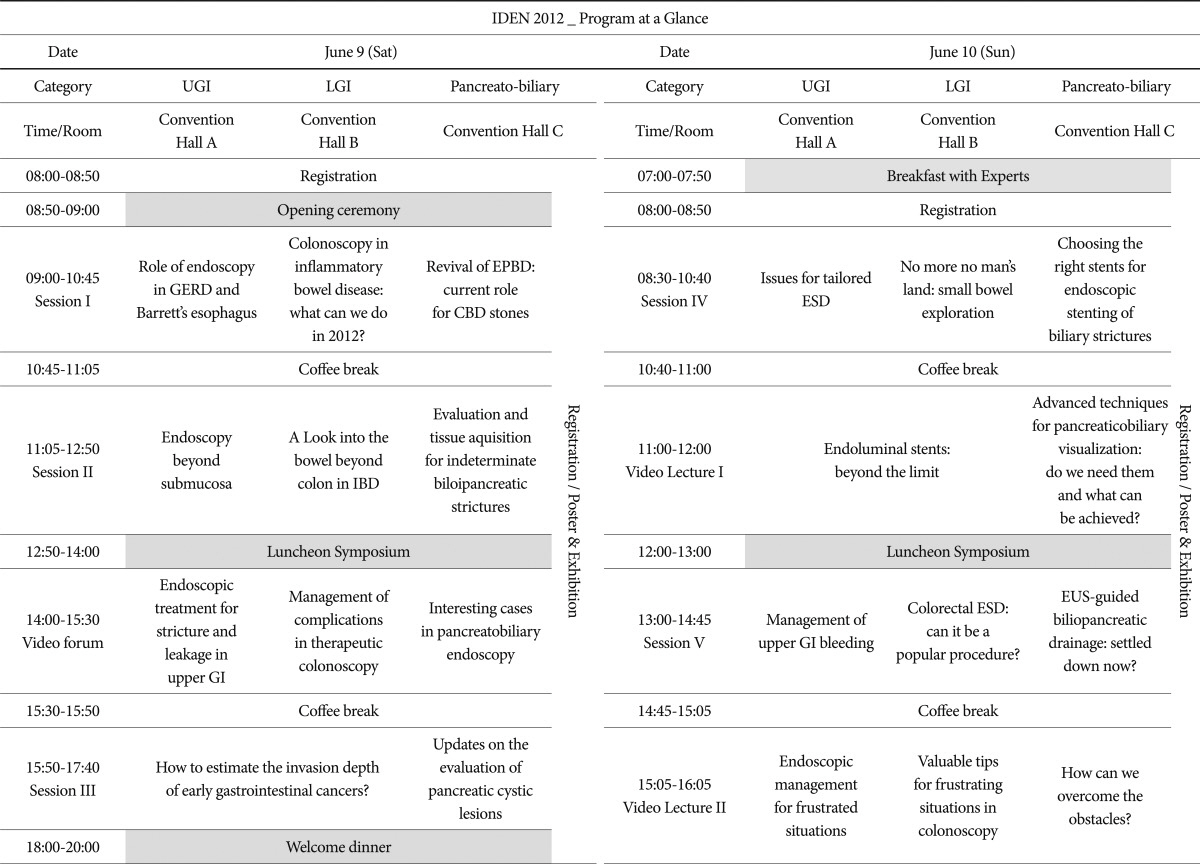Abstract
International Digestive Endoscopy Network (IDEN) is an international meeting covering scientific subjects of diverse topics about upper gastrointestinal (GI) endoscopy, colonoscopy, endoscopic ultrasonography, and PB endoscopy. IDEN is organized by Korean Society of Gastrointestinal Endoscopy and the Korean Gastrointestinal Endoscopy Research Foundation, and took its first step in 2011 in Seoul, Korea. IDEN inaugurated a new era of diagnostic and therapeutic GI endoscopy. IDEN 2012 was designed to offer participants from all over the world with opportunities to share up-to-date knowledge about basic and clinical aspects of GI endoscopy and to engage in in-depth discussion with worldwide well-known experts. During the 2 days of meeting, there were 62 invited lectures, 28 case-based discussions, 20 video lectures, and 6 breakfast with the experts. There were a total of 598 participants registered from 12 countries, including Asian countries, Europe, and USA as well as Korea.
International Digestive Endoscopy Network (IDEN) is organized by Korean Society of Gastrointestinal Endoscopy (KSGE) and the Korean Gastrointestinal Endoscopy Research Foundation. IDEN took its first step in 2011 in Seoul, Korea. IDEN 2012 (www.iden2012.org) was the second annual meeting, held on June 9 to 10, 2012 at Grand Hilton Hotel Convention Hall, Seoul, Korea. IDEN 2012 was designed to offer participants from all over the world with opportunities to share up-to-date knowledge about basic and clinical aspects of gastrointestinal (GI) endoscopy and to engage in in-depth discussion with worldwide well-known experts. The organizing committee had this dream of forming the 'INTERNATIONAL NETWORK' connecting the world through the 'DIGESTIVE ENDOSCOPY.'1
During IDEN 2012, scientific programs were held in two or three rooms designated for upper GI (UGI), lower GI (LGI), pancreatobiliary (PB) categories, respectively, as shown in Table 1. Twenty-two speakers were invited from overseas; more specifically, 13 from Japan, five from USA, one from Hong Kong, one from United Kingdom, one from Italy, and one from Belgium. They are all outstanding leaders in their fields of endoscopy. In addition, total of 92 Korean endoscopists participated the event as chairperson, speaker, and/or discussant (Fig. 1).
During the 2 days of meeting, there were 62 invited lectures, 28 case-based discussions, 20 video lectures, and 6 breakfast with the experts. Invited lectures and case-based discussions were grouped into 11 sessions according to their categories. Video lectures were grouped into 5 sessions. In every session, there were enthusiastic discussions with active participation from general audience. Small group participants of breakfast with the experts in early mornings shared their vivid and updated experiences with worldwide experts. There were a total of 598 participants registered from 12 countries, including other Asian countries (Cambodia, Hong Kong, Japan, Kazakhstan, Malaysia, Mongolia, and Vietnam), Europe (Belgium, Italy, and UK), and USA as well as Korea.
A total of 70 abstracts were submitted, and 18 of them were presented at the three video forum sessions in the fields of UGI, LGI, and PB. Videos were of excellent quality showing the highest level of scientific research, skills, and technologies in the practice of endoscopy. Among these 18 abstracts presented at the video forum, 6 outstanding abstracts were selected as the 'Best Video' in three categories of UGI, LGI, and PB. The presenters of each video were awarded a plaque and a prize of 500 US dollars. Fifty-two abstracts were presented as poster presentation during the meeting in the Emerald Hall. Among 152 posters, three outstanding posters were selected as the 'Best Poster' in three categories of UGI, LGI, and PB. The presenters of each poster were also awarded a plaque and a prize of 300 US dollars. Another 12 valuable posters were selected as 'Distinguished Poster.' Twenty-two global and domestic pharmaceutical and medical device companies sponsored the meeting and provided luncheon symposium in the plenary presentation. The exhibition was held at Convention Hall Lobby and Emerald Hall, open to all participants for 2 days.
In the IDEN 2012, all attendees could catch up the latest knowledge and share the newest experience about GI endoscopy through the invited lectures, case discussions, and video lectures. KSGE had taken proud in making such opportunity for attendees. On the 1st day, participants reviewed the role of endoscopy in gastroesophageal reflux disease;2 endoscopic treatment of subepithelial lesions and stricture/leakage; endoscopic ultrasound (EUS) in the estimation of early GI cancers;3 colonoscopy, enteroscopy, and computed tomography/magnetic resonance imaging in inflammatory bowel disease; large balloon dilatation for large bile duct stone; and tissue acquisition for bile duct disease. On the 2nd day, they reviewed everything about endoscopic submucosal dissection and endoluminal stents,4,5 management of GI bleeding, how to explore small bowel disease, advanced techniques for PB visualization, and how to approach EUS-guided PB drainage.
IDEN 2012 was a huge success. I am certain that it showed good model for globalization and internationalization of local endoscopy society. KSGE can be the role for center of ENDOSCOPY NETWORK through IDEN.
IDEN 2013 will be held on June 8 to 9, 2013 at Grand Hilton Hotel Convention Hall, Seoul, Korea. Hopefully, IDEN 2013 will become bigger and better than this year's meeting.
References
1. Lee SP, Lee HL, Hahm JS, Choi HS, Joe I, Shimizu S. International Live Endoscopic Multichannel Demonstration Using Superfast Broadband Internet Connections. Clin Endosc. 2012; 45:73–77. PMID: 22741135.

2. Kim KM, Cho YK, Bae SJ, et al. Prevalence of gastroesophageal reflux disease in Korea and associated health-care utilization: a national population-based study. J Gastroenterol Hepatol. 2012; 27:741–745. PMID: 21916988.

3. Kim EY. Introduction; value of endoscopic ultrasound-guided fine needle aspiration. Clin Endosc. 2012; 45:115–116. PMID: 22866249.

4. Kim EY, Jeon SW, Kim GH. Chicken soup for teaching and learning ESD. World J Gastroenterol. 2011; 17:2618–2622. PMID: 21677829.

5. Chung IK, Lee JH, Lee SH, et al. Therapeutic outcomes in 1,000 cases of endoscopic submucosal dissection for early gastric neoplasms: Korean ESD Study Group multicenter study. Gastrointest Endosc. 2009; 69:1228–1235. PMID: 19249769.





 PDF
PDF ePub
ePub Citation
Citation Print
Print




 XML Download
XML Download